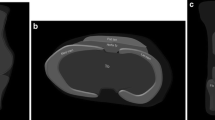Abstract
Objective
To determine the appropriate MRI criteria for the radiological diagnosis of significant quadriceps fat pad edema, to investigate the relationship between these criteria and anterior knee pain, and to evaluate possible structural and positional factors in the etiology.
Material and Methods
In this retrospective case–control study, individuals with and without quadriceps fat pad edema in the knee MRIs taken between May 2016 and December 2018 were determined as the case and control groups, respectively, in a ratio of 1:1. The MRI criteria for significant quadriceps fat pad edema were set as 10 mm and above the anterior–posterior diameter of the quadriceps fat pad, posterior convexity, and an increased signal in the fat-suppressed proton density sequence. The groups were compared for anterior knee pain, pain characteristics, working positions (sitting and standing), and MRI findings of structural factors. P < 0.05 was considered statistically significant.
Results
A total of 108 individuals were evaluated. Anterior knee pain was more common in the case group (49/54, p < 0.001) and was highly correlated with signs of quadriceps fat pad edema (R = -0,657). Frequent pain at night (18/54, p = 0.013), increased pain when walking upstairs (40/54, p = 0.003), knees are flexed (43/54, p < 0.001), and decreased pain when knees are extended (42/54, p < 0.001) were significantly high in the case group. No significant differences were observed in working position and structural factors.
Conclusion
Quadriceps fat pad edema is significantly associated with anterior knee pain and certain specific pain characteristics.



Similar content being viewed by others
References
Dixit S, DiFiori JP, Burton M, Mines B. Management of patellofemoral pain syndrome. Am Fam Physician. 2007;75(2):194–202.
McConnell J. The physical therapist’s approach to patellofemoral disorders. Clin Sports Med. 2002;21(3):363–87.
Green ST. Patellofemoral syndrome. J Bodyw Mov Ther. 2005;9(1):16–26.
Crossley KM, Callaghan MJ, van Linschoten R. Patellofemoral pain. Br J Sports Med. 2016;50(4):247–50.
Schweitzer ME, Falk A, Pathria M, Brahme S, Hodler J, Resnick D. MR imaging of the knee: can changes in the intracapsular fat pads be used as a sign of synovial proliferation in the presence of an effusion? AJR Am J Roentgenol. 1993;160(4):823–6.
Shabshin N, Schweitzer ME, Morrison WB. Quadriceps fat pad edema: significance on magnetic resonance images of the knee. Skeletal Radiol. 2006;35(5):269–74.
Roth C, Jacobson J, Jamadar D, Caoili E, Morag Y, Housner J. Quadriceps fat pad signal intensity and enlargement on MRI: prevalence and associated findings. AJR Am J Roentgenol. 2004;182(6):1383–7.
Kucukciloglu Y, Tuncyurek O. Anterior Knee Pain and Oedema-Like Changes of The Suprapatellar Fat Pad: Correlation of The Symptoms with MRI Findings. Current Medical Imaging. 2021;17(11):1350–5.
Polit, Denise F, Beck CT. Nursing research: Principles and methods: Lippincott Williams & Wilkins, 2004.
Dejour D, Le Coultre B. Osteotomies in patello-femoral instabilities. Sports Med Arthrosc Rev. 2007;15(1):39–46.
Insall J, Salvati E. Patella position in the normal knee joint. Radiology. 1971;101(1):101–4.
Wiberg G. Roentgenographs and Anatomic Studies on the Femoropatellar Joint: With Special Reference to Chondromalacia Patellae. Acta Orthop Scand. 1941;12(1–4):319–410.
Jungius KP, Schmid MR, Zanetti M, Hodler J, Koch P, Pfirrmann CW. Cartilaginous defects of the femorotibial joint: accuracy of coronal short inversion time inversion-recovery MR sequence. Radiology. 2006;240(2):482–8.
Tsavalas N, Karantanas AH. Suprapatellar fat-pad mass effect: MRI findings and correlation with anterior knee pain. AJR Am J Roentgenol. 2013;200(3):W291-296.
Staeubli HU, Bollmann C, Kreutz R, Becker W, Rauschning W. Quantification of intact quadriceps tendon, quadriceps tendon insertion, and suprapatellar fat pad: MR arthrography, anatomy, and cryosections in the sagittal plane. AJR Am J Roentgenol. 1999;173(3):691–8.
Author information
Authors and Affiliations
Corresponding author
Ethics declarations
Conflict of Interest
The authors declare that they have no competing interest.
Additional information
Publisher's Note
Springer Nature remains neutral with regard to jurisdictional claims in published maps and institutional affiliations.
Rights and permissions
About this article
Cite this article
Şam Özdemir, M., Ekin, E.E., Sari, K. et al. Do Patients Really Have Pain with Quadriceps Fat Pad Edema?. Skeletal Radiol 51, 1425–1432 (2022). https://doi.org/10.1007/s00256-021-03980-9
Received:
Revised:
Accepted:
Published:
Issue Date:
DOI: https://doi.org/10.1007/s00256-021-03980-9




